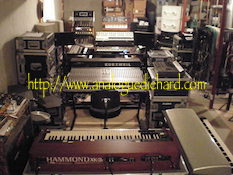

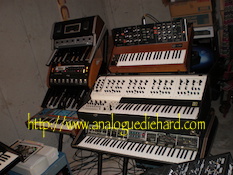
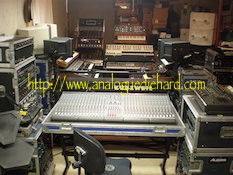
 |
 |
 |
 |
| Mixing Station |
Hammond/Rhodes/Drums | MIDI Station |
Epilogue |
| 2000 |
2009 |
2010 |
2011 |
2014 |
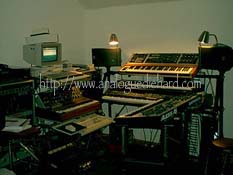 |
 |
 |
 |
 |
| The speakers swivel on the poles
so I can use them either at the mixer, the MIDI drums,
or the keyboards. Another goal was to maintain a low height profile
with all the gear so that the sound field from the monitors was not
interrupted. My studio monitors are the old JBL Control-5s with
companion subwoofer. Yes they're ancient but they have served my needs
well and I have no compelling reason to replace them (unless
replacement drivers or speaker cones are no longer available). There's racks on each side with FX; compressors, digital reverbs, EQs. Hard disk recorder is Alesis HD24 and it can be controlled over MMC from my sequencer computer. The A&H mixer has proven to be very versatile for the $$$, and almost all 40 channels are used (a 24 track recorder does not equal a 24 channel mixer). By keeping the height profile of racks to the sides low, the sound field from the monitors is not interrupted. I had initial concerns about reflections off the wall but it wasn't a problem. It's a good sounding arrangement. To minimize ear fatigue during extensive sessions I keep the monitor volume low. The JBL monitors are near field monitors that are designed for accurate reproduction but not projection - you don't use these to blast sound across the room. |
 |
| I occasionally gig the Hammond
XK3c/XLK3 so the assembly rests in the
lower lid of its Anvil case, ready to go. I prefer not to gig the
Rhodes - it is
an older 1967 model with original Raymac tines that
sound great but they don't hold their tuning when bumped around. The
MIDI drums is a hodgepodge of drum pads (Roland, Dauz, Simmons, Drum
Workshop, Acupad aka Hart Percussion, etc) that I acquired over
the years. I am a drummer and there are times when a pair of sticks
gets a more realistic performance than a MIDI keyboard. When I need to lay down drum parts on the MIDI drums, I can use the monitors from the mixing station. Another reason the monitor volume is kept low is that drums played too loud can blow the monitor drivers (yes it HAS happened). top |
 |
| Note the speakers rotated
around. Again in the interest of preventing
the sound field from being interrupted, I wanted to maintain a low
height profile of the keyboard stacks on the sides. As a side benefit,
I can see other members playing in the studio. The front keyboard is a master MIDI controller (Kurzweil MIDIBoard), which all things MIDI is centered around. The MIDI sequencer computer is immediately to the side. There's a tier above is that isn't specifically reserved for anything - I can use is as a music stand for wide scores or for another keyboard which is infrequently used (like my Korg DSS-1 sampler). Both sides are flanked with keyboard stacks and they all have MIDI retrofits. There was no way I could arrange all my keyboards from a central location so I reserved those positions for the ones with deep feature sets or those I frequently tweak so they are convenient. The sitting area looks cramped, but it really isn't. Even the stool is comfortable there, although there's only room for one person in that setup. From the sitting position the MIDI controller is comfortable, the monitors are pointed right at my ears (permitting low volume), the computer monitor is at eye level, I can reach all the boards to the side comfortably, and there's no more back strain! |
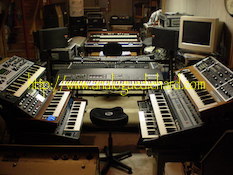 |
| There's a sliding tray under the
lowest keyboard on the right with the
keyboard and mouse for the MIDI sequencer computer. I build my parts on
the sequencer then dump audio to the hard disk recorder. The sequencer
can sync to the hard disk recorder via MIDI MMC so I have remote
control of the HD24 from the keyboards, or remote control of the
sequencer from the mixer. My old computer (shown here) finally died
after a 25+ year
life and I had to replace it with an Apple iMac and a MOTU MIDI Express
MIDI router. Another key component is the JLCooper MSB+ MIDI
patchbay,
which can configure the MIDI routing from where I am working. I can
control any area from any location and it's a really cool control
system. To each side of the MIDIboard are my racks with ROMplers, line mixers, effects processors, and EQ/power amp for the monitors. The racks are designed to just fit under the monitors (they don't call me the "master packer" for nothing!). Locating the racks for easy access while sitting at the MIDI controller required some compromise as some had to sit close to the floor. I chose to place the Kurzweil ROMplers close to the floor as I seldom needed to edit those sounds anymore and they are completely MIDI controlled. The power amp and EQ never needs touching other than power on/off. So my effects processors sit at accessible height because I tweak those often. One of the racks also doubles as a stand for my computer monitor. |
 |
| The keyboard stands on the sides
are the shorter 48 inch Standtastic
stands with three tiers on each. I have tried many keyboard stands and
the Standtastic is the most flexible and rugged model I have found.
Standtastics are best for a fixed location, others are better for quick
teardown/setup for stage work. My stage keyboard stands are Bespeco
(now K&M) and even then I had to modify them to fit my needs. The
MIDI controller sits on the one and only Ultimate stand I will ever
own; it initially was my sole keyboard studio stand in an "A" frame
format, but the tubular tiers proved to be unreliable as they were not
secure enough - one morning I found my Memorymoog on the floor from a
five foot drop due to a loose tier (!!!). You can't tighten the clamps
for the tiers for risk of splitting them, so there's no way to reliably
secure the tiers from rotating. Ultimate are my least favorite
keyboard stands. I re-configured the stand so it is a solid table support for the heavy/bulky MIDIBoard (which no longer "bounces" when I pound it like a piano), and as a bonus the vertical poles served as mounting posts for the studio monitors - right at ear level when I sit at the MIDIBoard. |
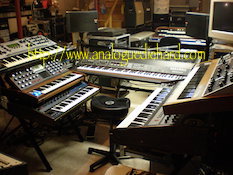 |
| The keyboards
behind the MIDI station. These either have shallow feature sets that
don't require much editing, or were impractical to place at the MIDI
station. It was a compromise but it works. I chose to use the
tall 60 inch Standtastic keyboard stands here, but only used three
tiers instead of five. That was driven by the size of the
instruments. The Oberheim FVS is a recent acquisition, awaiting restoration. The FVS is hardly a shallow feature instrument, but it is so frigging big that I couldn't stack anything above it up at the MIDI station without interrupting the sound field. The only practical place was behind the MIDI station. I have a surplus Highly Liquid UMR2 MIDI retrofit (now sadly out of production) that will only enable MIDI note on/off for the FVS keyboard but there is little else in the FVS that can be MIDI controlled. However the UMR2 will work over a 64 note range which extends the 49 note keyboard of the FVS. Since the FVS is only 25% programmable it does require extensive editing so I arranged it for use while standing up. It's an instrument that gets a lot of unique sounds and is lots of fun to experiment with. An original RAM Minimoog with Lintronics MIDI retrofit is above the FVS. Unlike the MIDI retrofit on the Source, the mod wheel can be controlled over MIDI on the Minimoog. On the bottom is a Polymoog, the first polyphonic synth I owned since 1985; I don't use it much anymore (it can't be MIDI'd) but it is the only instrument I am sentimental about. It is also a late production model with all the upgrades. Underneath the Polymoog is the companion subwoofer for the studio speakers. In the old setup they used to be too close to my listening perspective and I couldn't hear/feel the low frequencies due to longer wavelengths unless I stood back a distance (and I like bass). With them placed at the extreme end of the arrangement, now I can hear/feel the bass as they are far enough for the wavelengths to develop. That makes a difference with the drum kit which is now fifteen feet away from the subwoofer. |
 |
| The Taurus pedals were never
comfortable on the bottom tier near the
floor in the old setup. This time around I tried to place them up at
the MIDI station on the floor to the sides but that wasn't practical.
So I placed them on upper tiers of the tall stand. No I can't play them
with my feet, and no I don't care. I can play them with my hands or
from MIDI. Because of their shallow feature
set, not much editing is needed on them so their accessibility is good
there. These are Standtastic stands and the tiers for the pedals are
secure and solid. The Source still serves as a good bass synth; it may not have the solid fundamental of the Taurus pedals but it has features like variable pulse width/triangle waveforms and full ADSR EGs that get bass sounds the others can't. It has the Encore Electronics MIDI retrofit, I was one of their first customers when the retrofit was introduced in 1991. The Source is very good at fat synth leads but the MIDI retrofit doesn't control the mod wheel. When I want a stereo bass/ostinato synth sound I favor the Source through the Korg SDD-1200 which is a normalled signal path in my patchbay. |
 |
